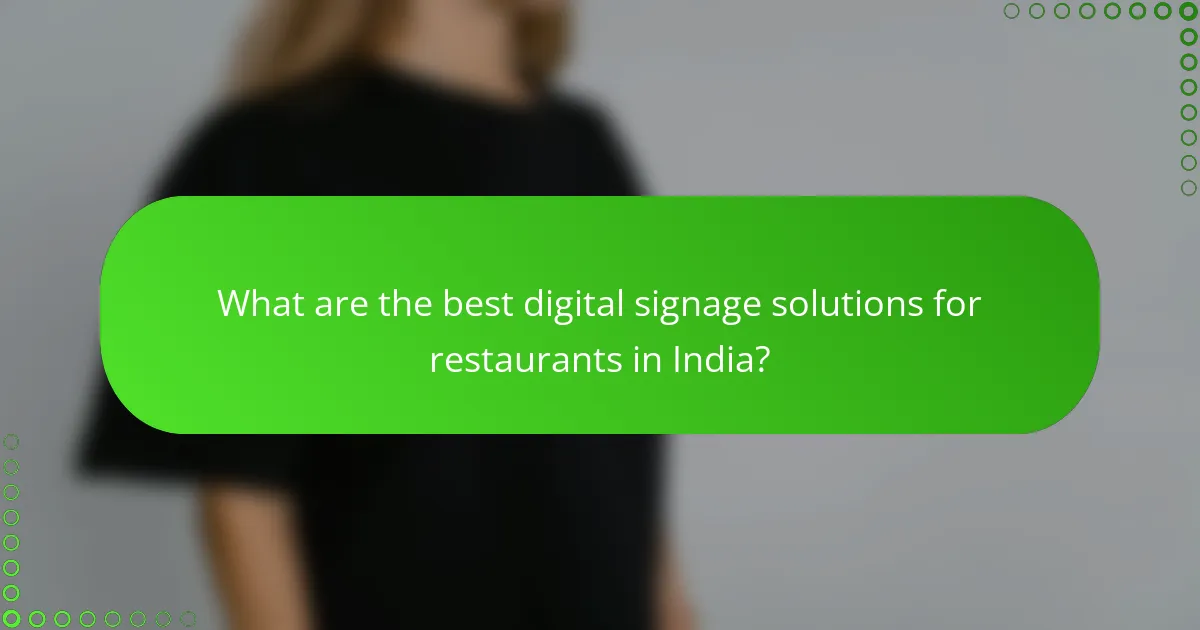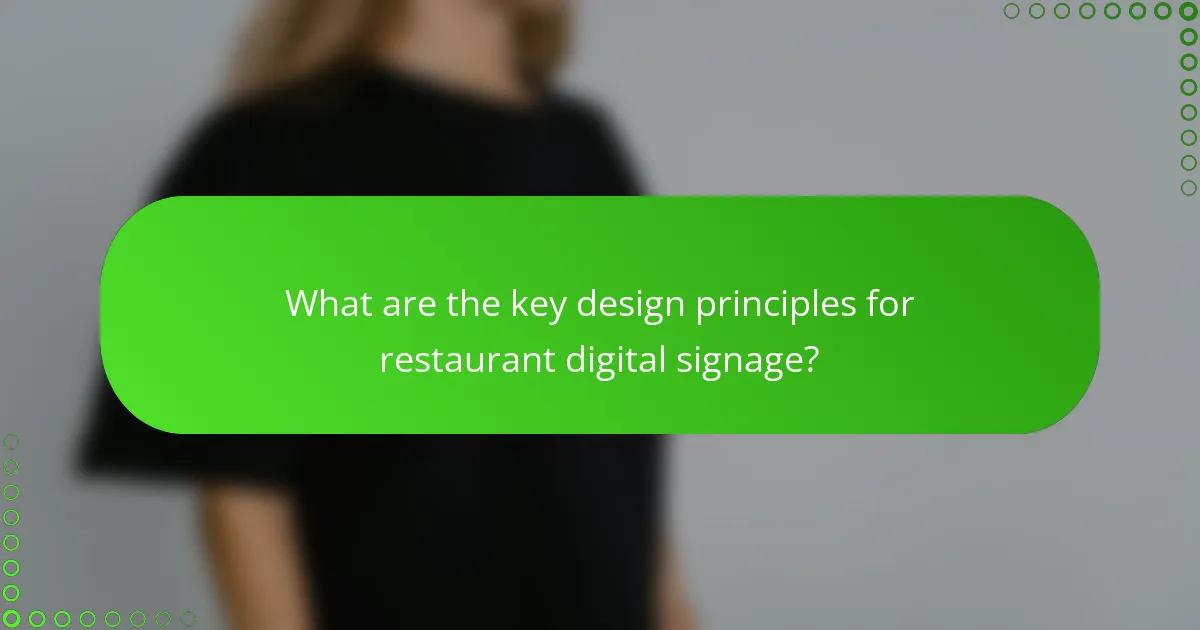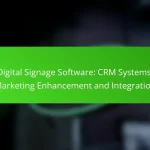Digital signage is transforming the dining experience in restaurants by delivering engaging and dynamic content that captivates customers. By utilizing reliable technologies and adhering to best design practices, restaurants can effectively communicate menu items and promotions, ultimately enhancing customer satisfaction and operational efficiency.

What are the best digital signage solutions for restaurants in India?
The best digital signage solutions for restaurants in India combine reliability, user-friendliness, and visual impact. Key options include BrightSign players, Samsung QLED displays, Scala content management systems, LG webOS signage solutions, and NEC display technology, each offering unique features suited for enhancing customer engagement and operational efficiency.
BrightSign digital signage players
BrightSign digital signage players are known for their robust performance and versatility. They support various media formats and can be easily integrated into existing systems, making them ideal for restaurants looking to display dynamic content.
Consider models like the BrightSign HD224 or XD234, which offer features such as 4K video playback and interactive capabilities. These players can be controlled remotely, allowing for quick updates to menus or promotions without physical access to the device.
Samsung QLED displays
Samsung QLED displays provide stunning picture quality and vibrant colors, enhancing the visual appeal of menu items. These displays are particularly effective in high-traffic areas, drawing attention with their bright and sharp images.
Restaurants should consider the size and resolution that best fits their space. The QLED series offers various sizes, from smaller 32-inch models to large 75-inch screens, allowing for flexible placement options.
Scala content management system
Scala is a powerful content management system that enables restaurants to create, manage, and schedule content across multiple screens. Its user-friendly interface allows staff to easily update promotions and menus in real-time.
Scala supports a variety of content types, including videos, images, and social media feeds, making it a versatile choice for engaging customers. Restaurants can also utilize templates to maintain brand consistency across different locations.
LG webOS signage solutions
LG webOS signage solutions offer an intuitive platform for managing digital signage content. With built-in Wi-Fi and a simple interface, these displays allow restaurant owners to easily upload and schedule content without needing extensive technical knowledge.
Models like the LG 55XE4F provide high brightness and clarity, making them suitable for both indoor and outdoor settings. Restaurants can benefit from the ability to customize content based on time of day or special events.
NEC display technology
NEC display technology is recognized for its reliability and high-quality visuals, making it a solid choice for restaurants. Their displays are designed for continuous operation, ensuring that content is always visible to customers.
NEC offers a range of display sizes and configurations, including ultra-narrow bezel options for video walls. This flexibility allows restaurants to create immersive experiences that can enhance customer engagement and drive sales.

How can digital signage enhance user experience in Indian restaurants?
Digital signage can significantly enhance user experience in Indian restaurants by providing clear, engaging, and dynamic content that captures customer attention. It streamlines communication of menu items, promotions, and interactive features, leading to a more informed and enjoyable dining experience.
Improved menu visibility
Digital signage improves menu visibility by displaying vibrant images and descriptions of dishes, making it easier for customers to make informed choices. High-resolution screens can showcase the restaurant’s specialties, including popular Indian dishes like biryani or paneer tikka, enticing customers with appealing visuals.
Consider using a rotating display that highlights different menu items throughout the day, such as breakfast options in the morning and lunch specials during the afternoon. This approach not only keeps the content fresh but also caters to varying customer preferences at different times.
Dynamic promotions and offers
Dynamic promotions and offers can be easily communicated through digital signage, allowing restaurants to update deals in real-time. For instance, a restaurant can promote happy hour discounts or special festival menus, ensuring that customers are aware of current offers without needing printed materials.
Utilizing eye-catching graphics and animations can draw attention to these promotions, increasing the likelihood of customer engagement. Regularly updating these offers can help maintain interest and encourage repeat visits, especially during festive seasons when special promotions are common in Indian cuisine.
Interactive customer engagement
Interactive customer engagement through digital signage can enhance the dining experience by allowing customers to browse menus, place orders, or provide feedback directly from the screen. Touchscreen interfaces can facilitate a seamless ordering process, reducing wait times and improving service efficiency.
Incorporating features such as customer polls or social media integration can further engage diners, creating a sense of community and connection. For example, displaying customer reviews or photos of dishes shared on social media can encourage others to participate and share their experiences, enhancing the restaurant’s visibility and appeal.

What are the key design principles for restaurant digital signage?
The key design principles for restaurant digital signage focus on enhancing customer engagement and streamlining communication. Effective signage should prioritize clarity, brand consistency, and optimal placement to ensure visibility and impact.
Clear typography and visuals
Using clear typography and engaging visuals is essential for effective digital signage in restaurants. Choose legible fonts that are easy to read from a distance, and ensure that text size is appropriate for the viewing environment. High-quality images and graphics can capture attention and convey messages quickly.
Consider using contrasting colors to enhance readability. For example, dark text on a light background or vice versa can improve visibility. Avoid cluttering the screen with too much information; instead, focus on key messages that can be absorbed at a glance.
Consistent branding elements
Consistency in branding elements across digital signage reinforces brand identity and builds customer recognition. Use your restaurant’s logo, color palette, and fonts consistently to create a cohesive look. This helps customers associate the signage with your brand, enhancing their overall experience.
Incorporate brand messaging that reflects your restaurant’s values and personality. For instance, if your establishment emphasizes sustainability, highlight eco-friendly practices in your signage. This not only strengthens brand identity but also resonates with customers who share similar values.
Strategic placement for visibility
Strategic placement of digital signage is crucial for maximizing visibility and impact. Position screens where they can easily catch the attention of diners, such as near entrances, waiting areas, or above ordering counters. Ensure that the signage is at eye level and unobstructed by furniture or other obstacles.
Consider the flow of customer traffic when determining placement. For example, placing a menu board near the entrance can help guide customers as they enter. Regularly assess the effectiveness of signage locations and adjust as needed to improve visibility and engagement.

How to choose the right digital signage software for restaurants?
Choosing the right digital signage software for restaurants involves evaluating features that enhance customer engagement and streamline operations. Key factors include scalability, user-friendliness, and integration capabilities with existing systems.
Scalability for multiple locations
When selecting digital signage software, ensure it can scale effectively across multiple restaurant locations. This means the software should allow for centralized management, enabling you to update content across all sites simultaneously.
Consider solutions that support cloud-based management, as they typically offer better scalability. Look for options that allow you to add new locations easily without significant additional costs or technical hurdles.
User-friendly interface
A user-friendly interface is crucial for restaurant staff who may not have technical expertise. The software should feature intuitive navigation and simple content creation tools, allowing employees to update menus or promotions quickly.
Evaluate platforms that offer drag-and-drop functionality and customizable templates. This can significantly reduce the time needed for training and increase the likelihood of staff utilizing the system effectively.
Integration with existing systems
Effective digital signage software should seamlessly integrate with your existing restaurant management systems, such as POS and inventory management. This integration helps ensure that your digital displays reflect real-time data, enhancing accuracy in menu displays and promotions.
Look for software that supports APIs or has pre-built integrations with popular restaurant management tools. This can streamline operations and reduce the risk of errors in displayed information, ultimately improving customer experience.

What are the costs associated with implementing digital signage in restaurants?
Implementing digital signage in restaurants involves several costs, including initial investments in hardware and software, ongoing content creation expenses, and maintenance fees. Understanding these costs helps restaurants budget effectively and maximize the return on investment.
Initial hardware and software investment
The initial investment for digital signage typically includes the cost of screens, media players, and software licenses. Depending on the quality and size of the displays, this can range from a few hundred to several thousand dollars per unit.
For example, a basic setup with a single screen might cost around USD 1,000, while a more advanced system with multiple screens and interactive capabilities could exceed USD 10,000. It’s essential to consider the long-term benefits of higher-quality equipment versus the upfront costs.
Ongoing content creation expenses
Content creation for digital signage can incur ongoing expenses, especially if the restaurant aims to keep its displays fresh and engaging. This may involve hiring graphic designers or using content management services, which can cost anywhere from USD 100 to USD 1,000 monthly, depending on the complexity and frequency of updates.
Restaurants should also consider the time spent on content creation, as this can impact staff productivity. Utilizing templates or automated content solutions can help reduce costs while maintaining quality.
Maintenance and support costs
Maintenance and support costs for digital signage can vary widely based on the system’s complexity and the service agreements in place. Regular maintenance might include software updates and hardware repairs, which could average USD 100 to USD 500 annually.
Additionally, having a support plan in place can prevent costly downtime. Restaurants should evaluate their needs and consider whether to handle maintenance in-house or outsource to a professional service to ensure optimal performance of their digital signage systems.






